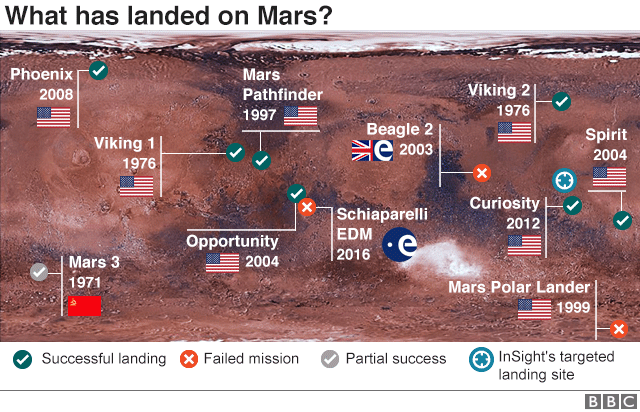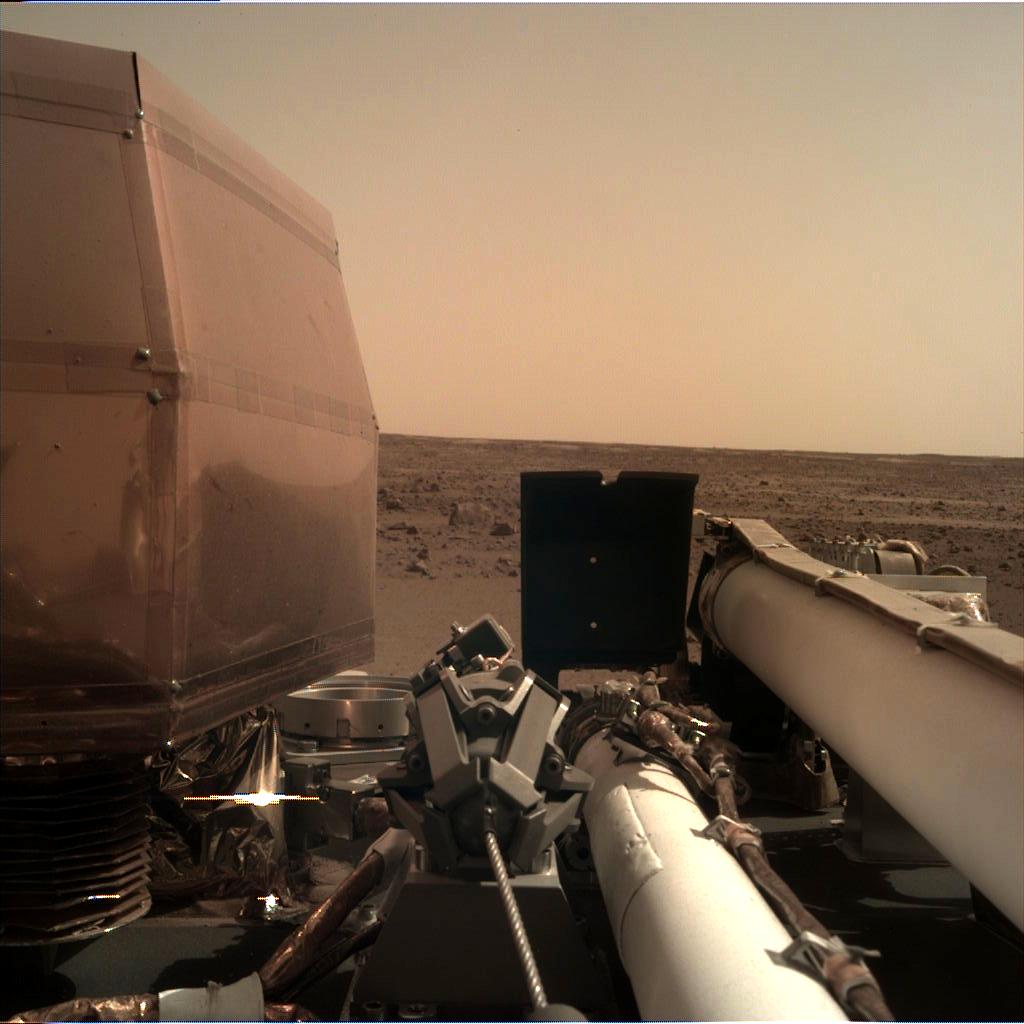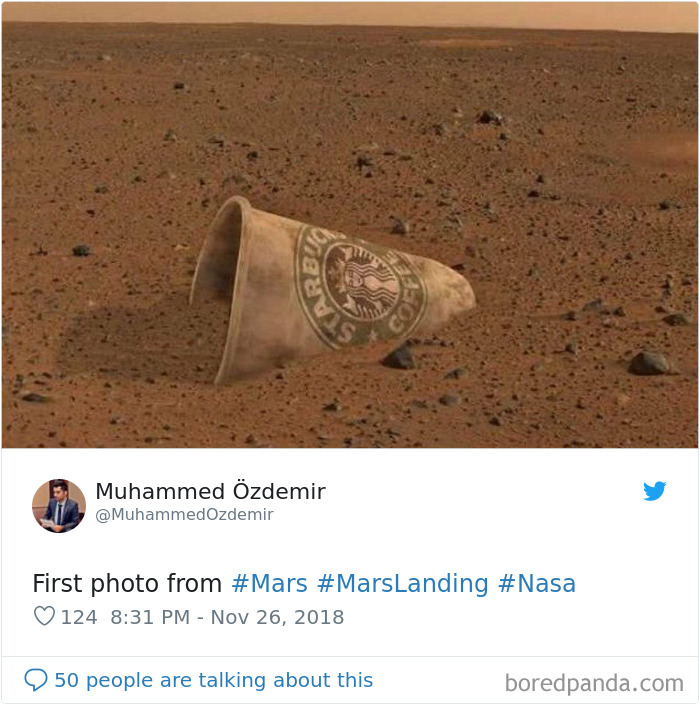Date: 26/11/2018 10:11:05
From: mollwollfumble
ID: 1308499
Subject: Mars landing
https://amp.theguardian.com/science/2018/nov/25/nasa-probe-challenge-land-mars-safely
1 Seismometer
Will record tremors from geological faults on Mars and shockwaves created by meteors that strike the ground
2 The Rise experiment
The Rotation and Interior Structure Experiment (Rise) uses radio equipment to track the precise position of the lander on the surface to reveal how much Mars wobbles as it orbits the sun. This is key to determining the size of Mars’s core and whether it is liquid or solid
3 Heat flow probe
Will burrow 5 metres into the ground to measure how fast heat rises from the planet’s interior.
Mollwollfumble has been waiting a long time for these three experiments. All three were present in some form on ALSEP, the experiment landed on the Moon by Apollo 11. It has been something of a long wait from 1969 to 2018 to see them landed on Mars.
Date: 26/11/2018 10:22:37
From: mollwollfumble
ID: 1308501
Subject: re: Mars landing
mollwollfumble said:
https://amp.theguardian.com/science/2018/nov/25/nasa-probe-challenge-land-mars-safely
1 Seismometer
Will record tremors from geological faults on Mars and shockwaves created by meteors that strike the ground
2 The Rise experiment
The Rotation and Interior Structure Experiment (Rise) uses radio equipment to track the precise position of the lander on the surface to reveal how much Mars wobbles as it orbits the sun. This is key to determining the size of Mars’s core and whether it is liquid or solid
3 Heat flow probe
Will burrow 5 metres into the ground to measure how fast heat rises from the planet’s interior.
Mollwollfumble has been waiting a long time for these three experiments. All three were present in some form on ALSEP, the experiment landed on the Moon by Apollo 11. It has been something of a long wait from 1969 to 2018 to see them landed on Mars.
Https://www.abc.net.au/news/science/2018-11-26/mars-insight-nasa-mission-to-take-the-red-planets-pulse/10490342
Has it landed yet? When exactly is it landing?
Date: 26/11/2018 10:24:36
From: Ian
ID: 1308504
Subject: re: Mars landing
Should be an interesting mission assuming they can land the sucker..
Compared with Phoenix, though, InSight’s landing presents four added challenges:
InSight enters the atmosphere at a lower velocity — 12,300 miles per hour (5.5 kilometers per second) vs. 12,500 miles per hour (5.6 kilometers per second).
InSight has more mass entering the atmosphere — about 1,340 pounds (608 kilograms) vs. 1,263 pounds (573 kilograms).
InSight lands at an elevation of about 4,900 feet (1.5 kilometers) higher than Phoenix did, so it has less atmosphere to use for deceleration.
InSight lands during northern hemisphere autumn on Mars, when dust storms are known to have grown to global proportions in some prior years.
https://mars.nasa.gov/insight/timeline/landing/entry-descent-landing/
Date: 26/11/2018 10:40:16
From: mollwollfumble
ID: 1308509
Subject: re: Mars landing
So far as I can tell, it was supposed to land about 4 hours ago. Not a whisper of how the landing went on the web.
Date: 26/11/2018 10:42:55
From: mollwollfumble
ID: 1308511
Subject: re: Mars landing
mollwollfumble said:
So far as I can tell, it was supposed to land about 4 hours ago. Not a whisper of how the landing went on the web.
Oops. No, I got the date wrong. Due to land roughly 20 hours from now.
Date: 26/11/2018 10:46:14
From: Peak Warming Man
ID: 1308512
Subject: re: Mars landing
Here’s how you can watch, from the comfort of planet Earth: NASA TV will be broadcasting the landing live online between 2 p.m. and 3:30 p.m. ET on Monday (Nov. 26). You can also watch the landing on other sites such as Facebook and Space.com.
You’ll have to work out the aussie time.
Date: 26/11/2018 10:49:43
From: Ian
ID: 1308513
Subject: re: Mars landing
mollwollfumble said:
mollwollfumble said:
So far as I can tell, it was supposed to land about 4 hours ago. Not a whisper of how the landing went on the web.
Oops. No, I got the date wrong. Due to land roughly 20 hours from now.
Good.
Like InSight, these two small spacecraft, together called Mars Cube One (or MarCO), will be boosted to a Mars-bound interplanetary trajectory. After trailing InSight on its way through the solar system, the solar-powered cubesats will serve as critical data relays while InSight plunges into the Martian atmosphere – where it will deploy a parachute at high speeds to slow down and finally use 12 small descent engines to lower itself to the surface.
Without these twin cubesats, data from the InSight probe that is relayed via the Mars Reconnaissance Orbiter can be delayed by as much as an hour because the Reconnaissance Orbiter has limitations on its ability to both receive and transmit simultaneously. MarCO will act like a ‘bring your own’ data relay, giving NASA prompt information about InSight’s landing (after the signals have traversed the distance from Mars to Earth of course).
Date: 26/11/2018 11:17:34
From: Michael V
ID: 1308516
Subject: re: Mars landing
Peak Warming Man said:
Here’s how you can watch, from the comfort of planet Earth: NASA TV will be broadcasting the landing live online between 2 p.m. and 3:30 p.m. ET on Monday (Nov. 26). You can also watch the landing on other sites such as Facebook and Space.com.
You’ll have to work out the aussie time.
https://www.nasa.gov/nasalive
Date: 26/11/2018 12:44:27
From: mollwollfumble
ID: 1308543
Subject: re: Mars landing
Michael V said:
Peak Warming Man said:
Here’s how you can watch, from the comfort of planet Earth: NASA TV will be broadcasting the landing live online between 2 p.m. and 3:30 p.m. ET on Monday (Nov. 26). You can also watch the landing on other sites such as Facebook and Space.com.
You’ll have to work out the aussie time.
https://www.nasa.gov/nasalive
A note from NASA TV. On earth, it normally takes three seismometers to locate an Earthquake.
On Mars, they’re trying to do it with one, and they may succeed. Because Mars is more solid, they catch seismic waves both from the actual event and from the opposite point after the surface waves have travelled more than 180 degrees around the planet. That gives a distance to the source, and it’s hoped that further processing will give the direction. The seismometer is supposed to be accurate enough to measure a deflection equivalent to one atom diameter.
The heat transfer experiment has it’s own little dome containment, with a rigid top dome, an accordion under that, and a bottom of chain mail to seal against the ground to protect the heat flux sensor from the wind. That gives about a 7.5 hour time delay in heat between the surface and the sensor.
MARCO is the pair of cubesats on their way to Mars. They will relay data from InSight back to Earth in X band. The camera on MARCO is still under test, operations staff are learning more with each photograph. They don’t know yet what MARCO’s orbit will be, or how many pictures it will take. MARCO has a pretty amazing little antenna – a flat screen that acts like a parabolic reflector – to communicate with Earth.
Date: 26/11/2018 12:51:29
From: Cymek
ID: 1308544
Subject: re: Mars landing
mollwollfumble said:
Michael V said:
Peak Warming Man said:
Here’s how you can watch, from the comfort of planet Earth: NASA TV will be broadcasting the landing live online between 2 p.m. and 3:30 p.m. ET on Monday (Nov. 26). You can also watch the landing on other sites such as Facebook and Space.com.
You’ll have to work out the aussie time.
https://www.nasa.gov/nasalive
A note from NASA TV. On earth, it normally takes three seismometers to locate an Earthquake.
On Mars, they’re trying to do it with one, and they may succeed. Because Mars is more solid, they catch seismic waves both from the actual event and from the opposite point after the surface waves have travelled more than 180 degrees around the planet. That gives a distance to the source, and it’s hoped that further processing will give the direction. The seismometer is supposed to be accurate enough to measure a deflection equivalent to one atom diameter.
The heat transfer experiment has it’s own little dome containment, with a rigid top dome, an accordion under that, and a bottom of chain mail to seal against the ground to protect the heat flux sensor from the wind. That gives about a 7.5 hour time delay in heat between the surface and the sensor.
MARCO is the pair of cubesats on their way to Mars. They will relay data from InSight back to Earth in X band. The camera on MARCO is still under test, operations staff are learning more with each photograph. They don’t know yet what MARCO’s orbit will be, or how many pictures it will take. MARCO has a pretty amazing little antenna – a flat screen that acts like a parabolic reflector – to communicate with Earth.
I bet it spends all it time with its eyes closed wandering around calling out for POLO
Date: 26/11/2018 13:15:03
From: mollwollfumble
ID: 1308551
Subject: re: Mars landing
https://mars.nasa.gov/resources/6981/landing-site-for-insight/?site=insight

There is supposed to be a website that doesn’t exist yet. “For the latest updates and more information about how to watch InSight landing, visit: https://go.nasa.gov/insighttoolkit “.
There are many places with official InSight landing parties, but they’re all in USA and Europe (except for one off the coast of Madagascar).
Online places. https://mars.nasa.gov/insight/timeline/landing/watch-online/
NASA Facebook Live Landing Coverage
NASA Periscope Live Landing Coverage
NASA Twitch Live Landing Coverage
NASA TV Media Live Landing Coverage (clean feed for media)
NASA TV Public Live Landing Coverage Post-landing Briefing
NASA Website Live Landing Coverage Post-landing Briefing
NASAJPL Facebook Live Landing Coverage (360 video)
NASAJPL YouTube Live Landing Coverage
NASAJPL Ustream Live Landing Coverage
NASAJPL2 Ustream Live Landing Coverage (clean feed for media)
JPLRaw YouTube Live Landing Coverage (clean feed for media)
Date: 26/11/2018 15:11:39
From: mollwollfumble
ID: 1308589
Subject: re: Mars landing
Date: 26/11/2018 19:03:14
From: Peak Warming Man
ID: 1308648
Subject: re: Mars landing
mollwollfumble said:

That landing graphic has given Insight a tick for a successful landing????
Has it landed???
Date: 26/11/2018 19:10:56
From: JudgeMental
ID: 1308652
Subject: re: Mars landing
Peak Warming Man said:
mollwollfumble said:

That landing graphic has given Insight a tick for a successful landing????
Has it landed???
look again, that tick is for Curiosity.
Date: 26/11/2018 19:11:48
From: Bubblecar
ID: 1308653
Subject: re: Mars landing
Peak Warming Man said:
mollwollfumble said:

That landing graphic has given Insight a tick for a successful landing????
Has it landed???
No, it’ll be landing tomorrow morning. Just before 7am our time.
https://www.abc.net.au/news/science/2018-11-26/mars-insight-nasa-mission-to-take-the-red-planets-pulse/10490342
Date: 26/11/2018 19:15:03
From: Peak Warming Man
ID: 1308656
Subject: re: Mars landing
JudgeMental said:
Peak Warming Man said:
mollwollfumble said:

That landing graphic has given Insight a tick for a successful landing????
Has it landed???
look again, that tick is for Curiosity.
Yes, I got excited I’d found a mistake on the internet and went early.
Date: 26/11/2018 19:16:51
From: Peak Warming Man
ID: 1308657
Subject: re: Mars landing
Bubblecar said:
Peak Warming Man said:
mollwollfumble said:

That landing graphic has given Insight a tick for a successful landing????
Has it landed???
No, it’ll be landing tomorrow morning. Just before 7am our time.
https://www.abc.net.au/news/science/2018-11-26/mars-insight-nasa-mission-to-take-the-red-planets-pulse/10490342
I’ll be there guiding it in every step of the way.
rubs hands
Date: 27/11/2018 05:00:41
From: mollwollfumble
ID: 1308731
Subject: re: Mars landing
One hour to Mars landing coverage on NASA TV
Date: 27/11/2018 05:59:15
From: mollwollfumble
ID: 1308737
Subject: re: Mars landing
mollwollfumble said:
One hour to Mars landing coverage on NASA TV
Mars landing coverage starting now.
Date: 27/11/2018 06:18:32
From: mollwollfumble
ID: 1308738
Subject: re: Mars landing
mollwollfumble said:
mollwollfumble said:
One hour to Mars landing coverage on NASA TV
Mars landing coverage starting now.
The landing itself will be shortly before 8 am Sydney time.
They have to let the dust settle, literally, before unfurling the solar arrays. That’s five and a half hours after landing before we’ll know if they deployed correctly.
Date: 27/11/2018 06:26:06
From: mollwollfumble
ID: 1308740
Subject: re: Mars landing
mollwollfumble said:
mollwollfumble said:
mollwollfumble said:
One hour to Mars landing coverage on NASA TV
Mars landing coverage starting now.
The landing itself will be shortly before 8 am Sydney time.
They have to let the dust settle, literally, before unfurling the solar arrays. That’s five and a half hours after landing before we’ll know if they deployed correctly.
The landing strategy is heavily based on Phoenix, not Curiosity or Opportunity. The parachute is stronger, deploys higher because the ground altitude is higher (less atmosphere) and the spacecraft is heavier.
Date: 27/11/2018 06:31:10
From: mollwollfumble
ID: 1308741
Subject: re: Mars landing
Dang it, before 7 am. That’s twice I’ve got the landing time wrong.
Date: 27/11/2018 06:32:57
From: mollwollfumble
ID: 1308742
Subject: re: Mars landing
The four communications relay satellites are in place and working, including both MARCOs.
Date: 27/11/2018 06:42:20
From: mollwollfumble
ID: 1308743
Subject: re: Mars landing
mollwollfumble said:
The four communications relay satellites are in place and working, including both MARCOs.
Both MARCOs now relaying information from Insight’s carrier.
Date: 27/11/2018 06:44:12
From: mollwollfumble
ID: 1308744
Subject: re: Mars landing
mollwollfumble said:
mollwollfumble said:
The four communications relay satellites are in place and working, including both MARCOs.
Both MARCOs now relaying information from Insight’s carrier.
Stations on ground Earth have confirmed that InSight is transmitting UHF. MARCO transmists on a different band, X-band.
Date: 27/11/2018 06:46:14
From: mollwollfumble
ID: 1308745
Subject: re: Mars landing
mollwollfumble said:
mollwollfumble said:
mollwollfumble said:
The four communications relay satellites are in place and working, including both MARCOs.
Both MARCOs now relaying information from Insight’s carrier.
Stations on ground Earth have confirmed that InSight is transmitting UHF. MARCO transmists on a different band, X-band.
Will be 1/2 minute between entry and the first deceleration, 6 1/2 minutes between entry and landing.
Date: 27/11/2018 06:49:08
From: Ian
ID: 1308746
Subject: re: Mars landing
JPL nerds looking happy…….
…standby………
Date: 27/11/2018 06:49:34
From: mollwollfumble
ID: 1308747
Subject: re: Mars landing
mollwollfumble said:
mollwollfumble said:
mollwollfumble said:
Both MARCOs now relaying information from Insight’s carrier.
Stations on ground Earth have confirmed that InSight is transmitting UHF. MARCO transmists on a different band, X-band.
Will be 1/2 minute between entry and the first deceleration, 6 1/2 minutes between entry and landing.
Peak heating rate now
Date: 27/11/2018 06:50:47
From: mollwollfumble
ID: 1308748
Subject: re: Mars landing
mollwollfumble said:
mollwollfumble said:
mollwollfumble said:
Stations on ground Earth have confirmed that InSight is transmitting UHF. MARCO transmists on a different band, X-band.
Will be 1/2 minute between entry and the first deceleration, 6 1/2 minutes between entry and landing.
Peak heating rate now
Passed peak deceleration, down to 8 Gs from a peak of 12.
Date: 27/11/2018 06:51:51
From: mollwollfumble
ID: 1308749
Subject: re: Mars landing
mollwollfumble said:
mollwollfumble said:
mollwollfumble said:
Will be 1/2 minute between entry and the first deceleration, 6 1/2 minutes between entry and landing.
Peak heating rate now
Passed peak deceleration, down to 8 Gs from a peak of 12.
Parachute deploy
Date: 27/11/2018 06:53:09
From: mollwollfumble
ID: 1308750
Subject: re: Mars landing
Radar lock on ground at a height of 1 km
Date: 27/11/2018 06:53:47
From: Peak Warming Man
ID: 1308751
Subject: re: Mars landing
Date: 27/11/2018 06:54:21
From: mollwollfumble
ID: 1308752
Subject: re: Mars landing
mollwollfumble said:
Radar lock on ground at a height of 1 km
200 metres 80, 60 50, 37, 20, 17 metres
Touchdown.
Date: 27/11/2018 06:55:07
From: Peak Warming Man
ID: 1308753
Subject: re: Mars landing
Touch down, the yanks are good at this stuff.
Date: 27/11/2018 06:55:14
From: Ian
ID: 1308754
Subject: re: Mars landing
mollwollfumble said:
mollwollfumble said:
Radar lock on ground at a height of 1 km
200 metres 80, 60 50, 37, 20, 17 metres
Touchdown.
:)
Date: 27/11/2018 06:59:33
From: mollwollfumble
ID: 1308755
Subject: re: Mars landing
mollwollfumble said:
mollwollfumble said:
Radar lock on ground at a height of 1 km
200 metres 80, 60 50, 37, 20, 17 metres
Touchdown.
Now to wait for the dust to settle. Literally. Not sure when we can expect to see the camera image, a 120 degree fisheye lens is mounted underneath the spacecraft.
Only 5 to 10 minutes before solar panels open.
Camera image. Got it. Lots of dust on the lens but can see the horizon. Great.
Date: 27/11/2018 07:00:42
From: Bubblecar
ID: 1308756
Subject: re: Mars landing
Damn, forgot all about this.
Still it looks like I wasn’t needed.
Date: 27/11/2018 07:01:55
From: mollwollfumble
ID: 1308758
Subject: re: Mars landing
mollwollfumble said:
mollwollfumble said:
mollwollfumble said:
Radar lock on ground at a height of 1 km
200 metres 80, 60 50, 37, 20, 17 metres
Touchdown.
Now to wait for the dust to settle. Literally. Not sure when we can expect to see the camera image, a 120 degree fisheye lens is mounted underneath the spacecraft.
Only 5 to 10 minutes before solar panels open.
Camera image. Got it. Lots of dust on the lens but can see the horizon. Great.
Some rocks visible in image. Will clean the lens with alcohol and get a better image later.
A possibility that Curiosity will have been able to see the parachute descent.
Date: 27/11/2018 07:06:24
From: mollwollfumble
ID: 1308759
Subject: re: Mars landing
mollwollfumble said:
mollwollfumble said:
mollwollfumble said:
200 metres 80, 60 50, 37, 20, 17 metres
Touchdown.
Now to wait for the dust to settle. Literally. Not sure when we can expect to see the camera image, a 120 degree fisheye lens is mounted underneath the spacecraft.
Only 5 to 10 minutes before solar panels open.
Camera image. Got it. Lots of dust on the lens but can see the horizon. Great.
Some rocks visible in image. Will clean the lens with alcohol and get a better image later.
A possibility that Curiosity will have been able to see the parachute descent.
The relay satellites have or soon will be out of position. So we have to wait until Mars Odyssey comes in range in 5 hours or so to find out if the solar panels are deploying properly.
Date: 27/11/2018 07:08:20
From: Peak Warming Man
ID: 1308760
Subject: re: Mars landing
There’s a dude walking around with a hat on.
Date: 27/11/2018 07:09:46
From: JudgeMental
ID: 1308761
Subject: re: Mars landing
Peak Warming Man said:
There’s a dude walking around with a hat on.
what, on Mars????
Date: 27/11/2018 07:10:50
From: mollwollfumble
ID: 1308762
Subject: re: Mars landing
mollwollfumble said:
The relay satellites have or soon will be out of position. So we have to wait until Mars Odyssey comes in range in 5 hours or so to find out if the solar panels are deploying properly.
I won’t be happy until the solar panels deploy. If you remember, Beagle landed perfectly but had to be written off because one of the solar panels didn’t deploy.
Date: 27/11/2018 08:02:53
From: Peak Warming Man
ID: 1308767
Subject: re: Mars landing
JudgeMental said:
Peak Warming Man said:
There’s a dude walking around with a hat on.
what, on Mars????
hehe.
Date: 27/11/2018 08:12:43
From: sibeen
ID: 1308769
Subject: re: Mars landing
Peak Warming Man said:
JudgeMental said:
Peak Warming Man said:
There’s a dude walking around with a hat on.
what, on Mars????
hehe.
Fucking Musk.
Date: 27/11/2018 08:19:29
From: JudgeMental
ID: 1308770
Subject: re: Mars landing
sibeen said:
Peak Warming Man said:
JudgeMental said:
what, on Mars????
hehe.
Fucking Musk.
and how does swmbo feel about that?
Date: 27/11/2018 09:24:33
From: Michael V
ID: 1308773
Subject: re: Mars landing
JudgeMental said:
sibeen said:
Peak Warming Man said:
hehe.
Fucking Musk.
and how does swmbo feel about that?
snigger
Date: 27/11/2018 09:26:20
From: Bubblecar
ID: 1308775
Subject: re: Mars landing
Hopefully someone down there will be able to give that a good wipe, without expecting a tip.

Date: 27/11/2018 09:29:23
From: Michael V
ID: 1308781
Subject: re: Mars landing
Bubblecar said:
Hopefully someone down there will be able to give that a good wipe, without expecting a tip.

Did they stop at a city intersection?
Date: 27/11/2018 09:31:20
From: Spiny Norman
ID: 1308784
Subject: re: Mars landing
Bugger, I missed it.
Have they found aliens yet?
Date: 27/11/2018 09:33:31
From: Bubblecar
ID: 1308788
Subject: re: Mars landing
Spiny Norman said:
Bugger, I missed it.
Have they found aliens yet?
Give them a chance, they’re still waiting for the dust to settle.
Date: 27/11/2018 09:36:56
From: Spiny Norman
ID: 1308790
Subject: re: Mars landing
Bubblecar said:
Spiny Norman said:
Bugger, I missed it.
Have they found aliens yet?
Give them a chance, they’re still waiting for the dust to settle.
With the very tenuous atmosphere that Mars has, I wouldn’t have thought that it’d take very long. The really fine dust particles do hang around though.
Date: 27/11/2018 09:40:09
From: captain_spalding
ID: 1308793
Subject: re: Mars landing
Bubblecar said:
Spiny Norman said:
Bugger, I missed it.
Have they found aliens yet?
Give them a chance, they’re still waiting for the dust to settle.
Yeah, something large descends from the sky, fires off some rocket motors, lands in your backyard, would you dash out right away and start poking at it with sticks?
No, you watch and wait, see if all the pyrotechnics are finished, see if there’s any more of them coming, maybe get on the phone to Alan Jones, and complain that you thought the boats had been stopped.
Date: 27/11/2018 19:40:40
From: mollwollfumble
ID: 1309040
Subject: re: Mars landing
Now I’m’ happy. The solar panels have opened and the camera is clean.
https://www.nasa.gov/feature/jpl/insight-is-catching-rays-on-mars
https://www.jpl.nasa.gov/spaceimages/details.php?id=PIA22575

The Instrument Deployment Camera (IDC), located on the robotic arm of NASA’s InSight lander, took this picture off the Martian surface on Nov. 26, 2018, the same day the spacecraft touched down on the Red Planet. The camera’s transparent dust cover is still on in this image, to prevent particulates kicked up during landing from settling on the camera’s lens. This image was relayed from InSight to Earth via NASA’s Odyssey spacecraft, currently orbiting Mars.
NASA’s InSight has sent signals to Earth indicating that its solar panels are open and collecting sunlight on the Martian surface. NASA’s Mars Odyssey orbiter relayed the signals, which were received on Earth at about 5:30 p.m. PST (8:30 p.m. EST). Solar array deployment ensures the spacecraft can recharge its batteries each day. Odyssey also relayed a pair of images showing InSight’s landing site.
“The InSight team and mollwollfumble can rest a little easier tonight now that we know the spacecraft solar arrays are deployed and recharging the batteries,”
It’s been a long day for the team. But tomorrow begins an exciting new chapter for InSight: surface operations and the beginning of the instrument deployment phase.
InSight’s twin solar arrays are each 2.2 meters wide; when they’re open, the entire lander is about the size of a big 1960s convertible. Mars has weaker sunlight than Earth because it’s much farther away from the Sun. But the lander doesn’t need much to operate: The panels provide 600 to 700 watts on a clear day.
Date: 27/11/2018 19:43:50
From: Divine Angel
ID: 1309041
Subject: re: Mars landing
Date: 27/11/2018 19:45:22
From: sibeen
ID: 1309043
Subject: re: Mars landing
mollwollfumble said:
Now I’m’ happy. The solar panels have opened and the camera is clean.
https://www.nasa.gov/feature/jpl/insight-is-catching-rays-on-mars
https://www.jpl.nasa.gov/spaceimages/details.php?id=PIA22575

The Instrument Deployment Camera (IDC), located on the robotic arm of NASA’s InSight lander, took this picture off the Martian surface on Nov. 26, 2018, the same day the spacecraft touched down on the Red Planet. The camera’s transparent dust cover is still on in this image, to prevent particulates kicked up during landing from settling on the camera’s lens. This image was relayed from InSight to Earth via NASA’s Odyssey spacecraft, currently orbiting Mars.
NASA’s InSight has sent signals to Earth indicating that its solar panels are open and collecting sunlight on the Martian surface. NASA’s Mars Odyssey orbiter relayed the signals, which were received on Earth at about 5:30 p.m. PST (8:30 p.m. EST). Solar array deployment ensures the spacecraft can recharge its batteries each day. Odyssey also relayed a pair of images showing InSight’s landing site.
“The InSight team and mollwollfumble can rest a little easier tonight now that we know the spacecraft solar arrays are deployed and recharging the batteries,”
It’s been a long day for the team. But tomorrow begins an exciting new chapter for InSight: surface operations and the beginning of the instrument deployment phase.
InSight’s twin solar arrays are each 2.2 meters wide; when they’re open, the entire lander is about the size of a big 1960s convertible. Mars has weaker sunlight than Earth because it’s much farther away from the Sun. But the lander doesn’t need much to operate: The panels provide 600 to 700 watts on a clear day.
That is a stunning photograph.
Date: 27/11/2018 19:48:32
From: Divine Angel
ID: 1309046
Subject: re: Mars landing
mollwollfumble said:
But the lander doesn’t need much to operate: The panels provide 600 to 700 watts on a clear day.
How often does Mars have clear days?
Date: 27/11/2018 19:50:24
From: sibeen
ID: 1309048
Subject: re: Mars landing
Divine Angel said:
mollwollfumble said:
But the lander doesn’t need much to operate: The panels provide 600 to 700 watts on a clear day.
How often does Mars have clear days?
Except for the occasional dust storm, every day. It’s not as if it is going to rain.
Date: 27/11/2018 19:51:43
From: Arts
ID: 1309049
Subject: re: Mars landing
mollwollfumble said:
Now I’m’ happy. The solar panels have opened and the camera is clean.
https://www.nasa.gov/feature/jpl/insight-is-catching-rays-on-mars
https://www.jpl.nasa.gov/spaceimages/details.php?id=PIA22575

The Instrument Deployment Camera (IDC), located on the robotic arm of NASA’s InSight lander, took this picture off the Martian surface on Nov. 26, 2018, the same day the spacecraft touched down on the Red Planet. The camera’s transparent dust cover is still on in this image, to prevent particulates kicked up during landing from settling on the camera’s lens. This image was relayed from InSight to Earth via NASA’s Odyssey spacecraft, currently orbiting Mars.
NASA’s InSight has sent signals to Earth indicating that its solar panels are open and collecting sunlight on the Martian surface. NASA’s Mars Odyssey orbiter relayed the signals, which were received on Earth at about 5:30 p.m. PST (8:30 p.m. EST). Solar array deployment ensures the spacecraft can recharge its batteries each day. Odyssey also relayed a pair of images showing InSight’s landing site.
“The InSight team and mollwollfumble can rest a little easier tonight now that we know the spacecraft solar arrays are deployed and recharging the batteries,”
It’s been a long day for the team. But tomorrow begins an exciting new chapter for InSight: surface operations and the beginning of the instrument deployment phase.
InSight’s twin solar arrays are each 2.2 meters wide; when they’re open, the entire lander is about the size of a big 1960s convertible. Mars has weaker sunlight than Earth because it’s much farther away from the Sun. But the lander doesn’t need much to operate: The panels provide 600 to 700 watts on a clear day.
I think I can see my house from there
Date: 27/11/2018 19:53:26
From: The Rev Dodgson
ID: 1309051
Subject: re: Mars landing
sibeen said:
Divine Angel said:
mollwollfumble said:
But the lander doesn’t need much to operate: The panels provide 600 to 700 watts on a clear day.
How often does Mars have clear days?
Except for the occasional dust storm, every day. It’s not as if it is going to rain.
The internet tells me that Mars receives a flux of ~593 W/m 2 from the sun.
I thought it would be less than that.
Date: 27/11/2018 19:57:13
From: Divine Angel
ID: 1309052
Subject: re: Mars landing
I thought dust storms were regular occurrences, not occasional.
Date: 27/11/2018 22:02:57
From: mollwollfumble
ID: 1309123
Subject: re: Mars landing
The Rev Dodgson said:
sibeen said:
Divine Angel said:
How often does Mars have clear days?
Except for the occasional dust storm, every day. It’s not as if it is going to rain.
The internet tells me that Mars receives a flux of ~593 W/m 2 from the sun.
I thought it would be less than that.
I thought it would be less than that, too. Say 1367 W/m2 for Earth at Equator. Divide by square of Mars orbit. 1367 / 1.5^2 = 600 W/m2. No, it’s right.
Divine Angel said:
I thought dust storms were regular occurrences, not occasional.
Wikipedia makes no sense. “The chance for storms is increased when there are great temperature variations like those seen at the equator during the Martian summer.” When it’s summer in the north it’s winter in the south and vice versa, doesn’t apply on the equator.
“Dust storms are most common during perihelion, when the planet receives 40 percent more sunlight than during aphelion.” That makes more sense.
Global dust storms have been observed on Mars in 1971, 2001, 2007 and 2018. “chances of a planet-wide dust storm in a particular Martian year are approximately one in three”.
Date: 28/11/2018 10:47:33
From: mollwollfumble
ID: 1309222
Subject: re: Mars landing
Oh I gotta share this. Bored Panda has posted pictures of InSight’s landing. As misinterpreted in Photoshop and other ways.
https://www.boredpanda.com/funny-nasa-insight-mars-landing-reactions/






Date: 28/11/2018 11:05:40
From: Michael V
ID: 1309231
Subject: re: Mars landing
mollwollfumble said:
Oh I gotta share this. Bored Panda has posted pictures of InSight’s landing. As misinterpreted in Photoshop and other ways.
https://www.boredpanda.com/funny-nasa-insight-mars-landing-reactions/






:)
Date: 28/11/2018 15:49:26
From: mollwollfumble
ID: 1309296
Subject: re: Mars landing
Compare InSight to Phoenix.
InSight

Phoenix

Identical. Almost. Same descent and landing method, too.
Date: 28/11/2018 16:38:38
From: Peak Warming Man
ID: 1309305
Subject: re: Mars landing
mollwollfumble said:
Now I’m’ happy. The solar panels have opened and the camera is clean.
https://www.nasa.gov/feature/jpl/insight-is-catching-rays-on-mars
https://www.jpl.nasa.gov/spaceimages/details.php?id=PIA22575

The Instrument Deployment Camera (IDC), located on the robotic arm of NASA’s InSight lander, took this picture off the Martian surface on Nov. 26, 2018, the same day the spacecraft touched down on the Red Planet. The camera’s transparent dust cover is still on in this image, to prevent particulates kicked up during landing from settling on the camera’s lens. This image was relayed from InSight to Earth via NASA’s Odyssey spacecraft, currently orbiting Mars.
NASA’s InSight has sent signals to Earth indicating that its solar panels are open and collecting sunlight on the Martian surface. NASA’s Mars Odyssey orbiter relayed the signals, which were received on Earth at about 5:30 p.m. PST (8:30 p.m. EST). Solar array deployment ensures the spacecraft can recharge its batteries each day. Odyssey also relayed a pair of images showing InSight’s landing site.
“The InSight team and mollwollfumble can rest a little easier tonight now that we know the spacecraft solar arrays are deployed and recharging the batteries,”
It’s been a long day for the team. But tomorrow begins an exciting new chapter for InSight: surface operations and the beginning of the instrument deployment phase.
InSight’s twin solar arrays are each 2.2 meters wide; when they’re open, the entire lander is about the size of a big 1960s convertible. Mars has weaker sunlight than Earth because it’s much farther away from the Sun. But the lander doesn’t need much to operate: The panels provide 600 to 700 watts on a clear day.
Have all the panels deployed correctly, one looks to be still sticking up in that phots?
Date: 28/11/2018 22:06:03
From: mollwollfumble
ID: 1309469
Subject: re: Mars landing
Peak Warming Man said:
mollwollfumble said:
Now I’m’ happy. The solar panels have opened and the camera is clean.
https://www.nasa.gov/feature/jpl/insight-is-catching-rays-on-mars
https://www.jpl.nasa.gov/spaceimages/details.php?id=PIA22575

The Instrument Deployment Camera (IDC), located on the robotic arm of NASA’s InSight lander, took this picture off the Martian surface on Nov. 26, 2018, the same day the spacecraft touched down on the Red Planet. The camera’s transparent dust cover is still on in this image, to prevent particulates kicked up during landing from settling on the camera’s lens. This image was relayed from InSight to Earth via NASA’s Odyssey spacecraft, currently orbiting Mars.
NASA’s InSight has sent signals to Earth indicating that its solar panels are open and collecting sunlight on the Martian surface. NASA’s Mars Odyssey orbiter relayed the signals, which were received on Earth at about 5:30 p.m. PST (8:30 p.m. EST). Solar array deployment ensures the spacecraft can recharge its batteries each day. Odyssey also relayed a pair of images showing InSight’s landing site.
“The InSight team and mollwollfumble can rest a little easier tonight now that we know the spacecraft solar arrays are deployed and recharging the batteries,”
It’s been a long day for the team. But tomorrow begins an exciting new chapter for InSight: surface operations and the beginning of the instrument deployment phase.
InSight’s twin solar arrays are each 2.2 meters wide; when they’re open, the entire lander is about the size of a big 1960s convertible. Mars has weaker sunlight than Earth because it’s much farther away from the Sun. But the lander doesn’t need much to operate: The panels provide 600 to 700 watts on a clear day.
Have all the panels deployed correctly, one looks to be still sticking up in that phots?
Is it? I haven’t seen that. All I know for sure is that it’s getting plenty of solar power.
Some more humour.











